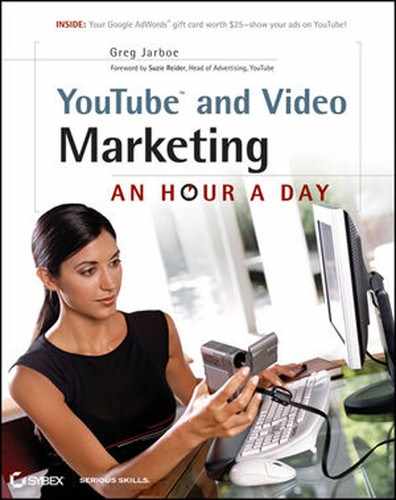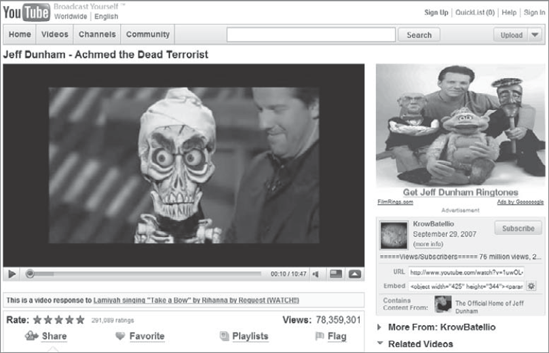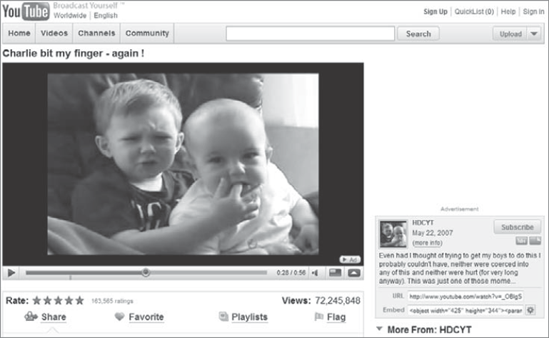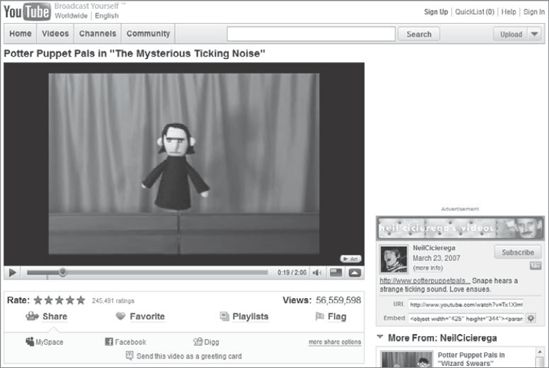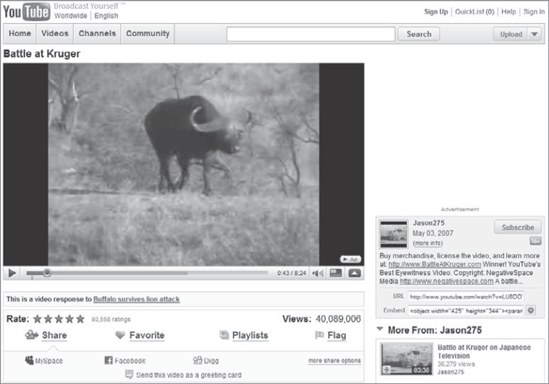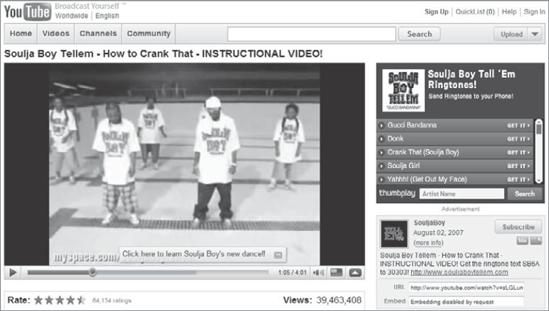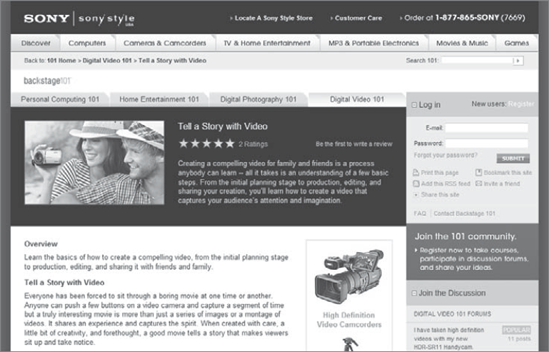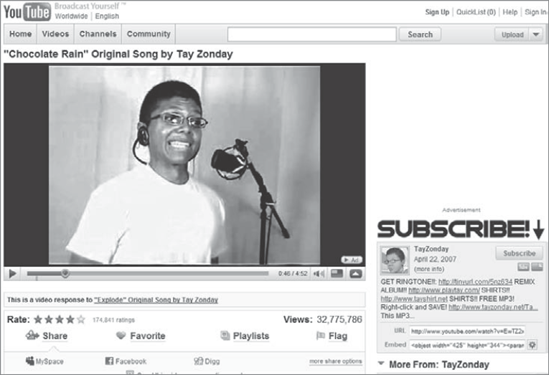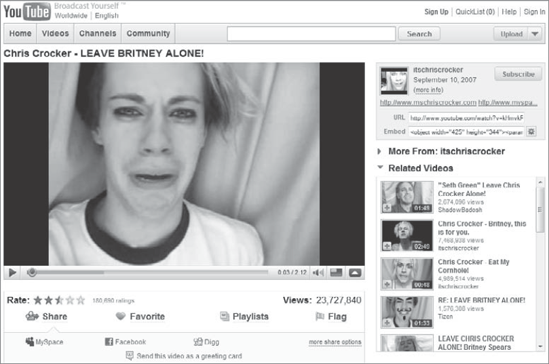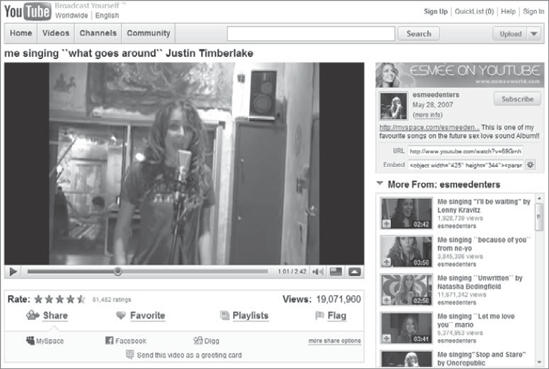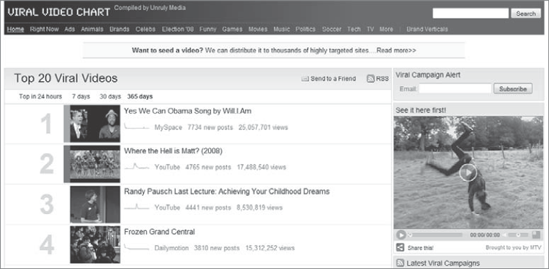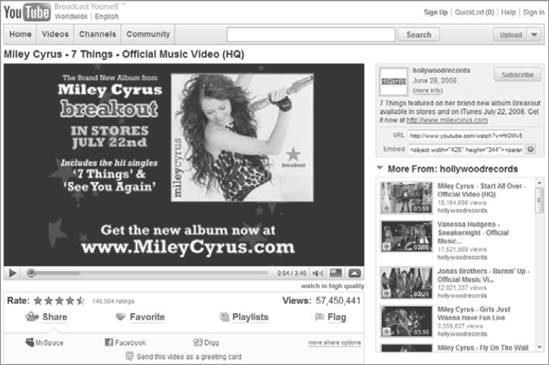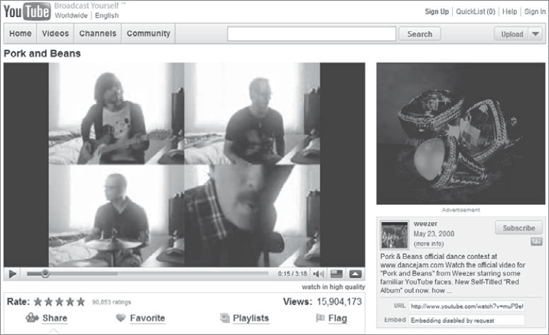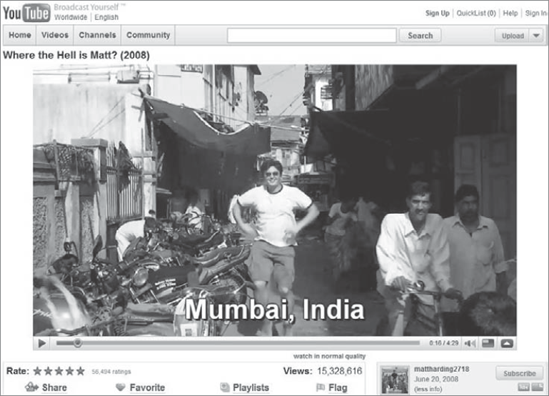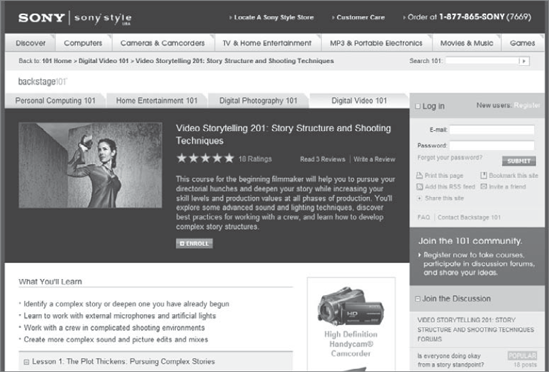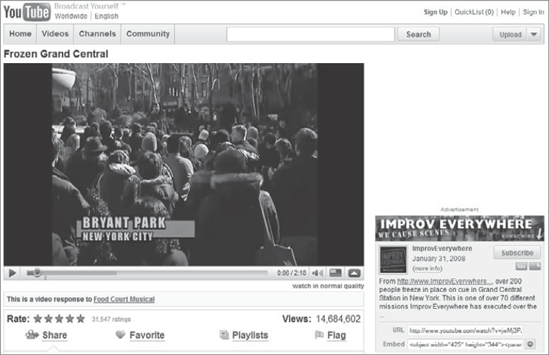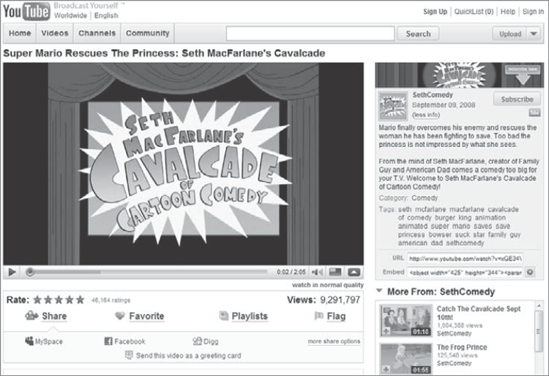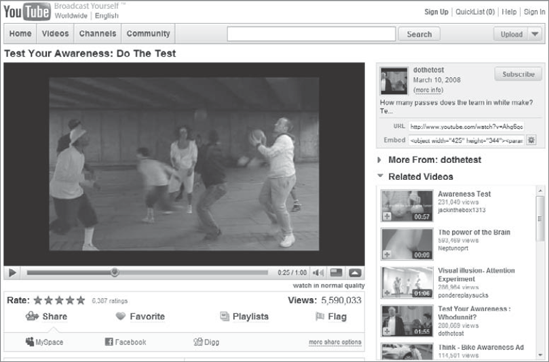Yogi Berra said, "You can observe a lot just by watching." If you want to learn how to make a viral video, then what he said actually makes sense.
In this chapter, you'll watch the best viral videos of 2007 and 2008 to learn how to make original content worth watching and compelling content worth sharing. After you've learned how to create a viral video, you can tell your close friends, "I can't wait to see what you're like online."
Chapter Contents:
See the Power of "The Last Lecture"
Week 1: Watch the Best Viral Videos of 2007
Week 2: Make Original Content Worth Watching
Week 3: Observe the Top Viral Videos of 2008
Week 4: Create Compelling Content Worth Sharing
YouTube's slogan is "Broadcast Yourself." And millions of people are broadcasting themselves to the YouTube community, including: amateur and professional and established filmmakers; aspiring and professional musicians; comedians; personal video creators such as cooking, beauty, health, and fitness experts; and professional content owners.
Although optimizing a new video's title, description, and tags can help opinion leaders discover it when conducting a relevant query, it is the content of the new video that determines whether it is worth watching—and, more importantly, worth sharing with their followers.
So, opinion leaders don't judge a video by its title. Although discovery is mainly a transfer of information, the decision to share a video also involves using their interpersonal influence. As Figure 5.1 illustrates, that's why an opinion leader says, "I can't wait to see what you're like online."
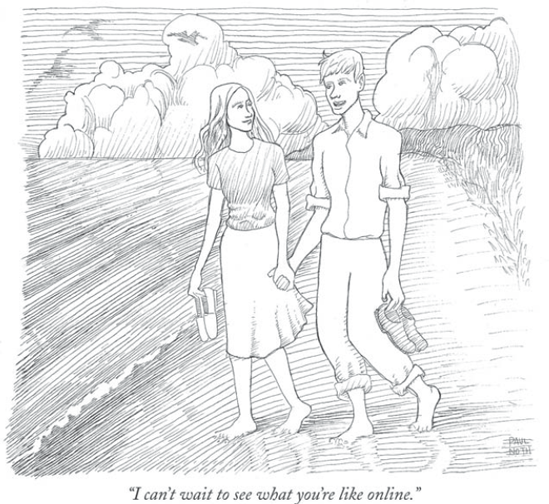
Figure 5.1. "I can't wait to see what you're like online." (Cartoon by Paul Noth in The New Yorker, July 4, 2005.)
Let me give you an example to make this two-step process clear.
My wife, Nancy, read The Last Lecture, the New York Times best-selling book written by Randy Pausch, a professor at Carnegie Mellon University. The book was born out of a lecture Pausch gave in September 2007 entitled "Really Achieving Your Childhood Dreams."
After reading the book, which is 224 pages long, Nancy decided to buy copies to give as Christmas presents to all three of our kids in 2008. Although I hadn't read the book, I discovered a video of Pausch's last lecture on the CarnegieMellonU channel on YouTube.
I wasn't the first to discover the video. As Figure 5.2 illustrates, "Randy Pausch Last Lecture: Achieving Your Childhood Dreams" had more than 8 million views on YouTube as of January 1, 2009.
But if you look closely, you'll also notice that the video is 1 hour, 16 minutes, and 27 seconds long. So the decision to watch it wasn't trivial. And the view count in YouTube doesn't mean someone watched more than half of the video, which is how Dailymotion counts a "view." But, I figured that I could watch the video in less time than I could read the book. And I could click away at any time if the video turned out to be boring.
Pausch's moving presentation wasn't boring. His talk was modeled after an ongoing series of lectures where top academics were asked to think deeply about the question, What wisdom would you try to impart to the world if you knew it was your last chance?
A month before giving the lecture, Pausch had received a prognosis that the pancreatic cancer with which he had been diagnosed a year earlier was terminal. Before speaking, Pausch received a long standing ovation from a large crowd of over 400 colleagues and students. When he motioned them to sit down, saying, "Make me earn it," some in the audience shouted back, "You did!"
During the lecture Pausch was upbeat and humorous, shrugging off the pity often given to those diagnosed with a terminal illness. At one point, to prove his own vitality, Pausch dropped down and did push-ups on stage.
He offered insights on computer science and engineering education, multidisciplinary collaborations, and working in groups and interacting with other people. Pausch also offered his listeners inspirational life advice that can be applied to one's professional and personal life.
At the end of 1:16:27, I was in tears. On New Year's Day, I shared a link to the video with my kids, just in case they hadn't read the book yet. Although there's no substitute for reading the book, not everyone has the time. And once you've seen the video, you make time to read the book.
Before you learn how to make a viral video, let me define what one is.
According to Wikipedia, "A viral video is a video clip that gains widespread popularity through the process of Internet sharing, typically through email or Instant messaging, blogs and other media sharing websites." It adds, "Viral videos are often humorous in nature."
Wikipedia gives some examples of viral videos, including televised comedy sketches such as Saturday Night Live's "Lazy Sunday" from 2005; amateur video clips like Judson Laipply's "Evolution of Dance" from 2006; and Web-only productions such as Obama Girl's "I Got a Crush...On Obama" from 2007. Some "eyewitness" events have also been caught on video and have gone viral, including the "Battle at Kruger" from 2007.
You'll get a better idea of what a viral video is by watching some. But before we start, are there any questions?
Search Engine Marketer: "What is the best digital camcorder?"
YouTube Director: "What is the best video editing software?"
Small Businessperson: "What is the worst that can happen?"
Those are all good questions and I'll tackle them in Chapter 8, which is about video production. But this chapter is about video content. Good production is important, but it won't save bad content.
If you need a professional example, compare Star Wars Episode IV: A New Hope from the original trilogy with Star Wars Episode I: The Phantom Menace from the prequel trilogy. Although the production quality had improved two decades later, the content hadn't.
If you want an amateur example, watch "Star Wars according to a 3 year old." Fans of the film can go on for hours discussing the plot, but this sweet-faced little lady sums it up in less than two minutes. If not the most detailed description of Star Wars ever, it's arguably the most adorable. As Figure 5.3 illustrates, it had about 10 million views as of January 1, 2009.
If a three-year-old can become a YouTube sensation just by retelling the original Star Wars story, then don't underestimate the Force of content. With that in mind, let's check out some of the best viral videos of 2007:
Monday: Observe "Jeff Dunham - Achmed the Dead Terrorist"
Tuesday: See "Charlie bit my finger–again!"
Wednesday: Check out "Potter Puppet Pals in 'The Mysterious Ticking Noise'"
Thursday: Look at "Battle at Kruger"
Friday: View "Soulja Boy Tellem - How to Crank That - INSTRUCTIONAL VIDEO"
One of the best viral videos of 2007 is "Jeff Dunham - Achmed the Dead Terrorist." As Figure 5.4 illustrates, it had more than 78 million views on YouTube as of January 1, 2009, making it the #6 most viewed video of all time in any category.
If you look at the statistics and data for this video, you will also see that it has six honors:
#28 - Most Discussed (All Time)
#3 - Most Discussed (All Time - Entertainment
#6 - Most Viewed (All Time)
#1 - Most Viewed (All Time - Entertainment
#2 - Top Favorited (All Time)
#1 - Top Favorited (All Time - Entertainment
Dunham is an American ventriloquist and stand-up comedian. He has performed at comedy clubs across the United States since the late 1980s and has also appeared on numerous television shows, including Late Show with David Letterman and The Tonight Show. In January 2008, Dunham was voted the top comedian in Comedy Central's "Stand-Up Showdown."
Dunham's act includes seven puppets, known by his fans as the Suitcase Posse. They include Achmed the Dead Terrorist, Bubba J, José Jalapeño on a Stick, Melvin the Superhero, Peanut, Sweet Daddy D, and Walter. Although each puppet has a backstory and Dunham brings them all to life, the one that's gone viral is Achmed.
The skeletal corpse of an incompetent suicide bomber, Achmed is used by Dunham to perform comedy based on the contemporary issue of terrorism. Achmed is known for yelling, "Silence! I kill you!" to people in the audience who laugh at his customs. The dead terrorist first appeared in "Spark of Insanity" and made an appearance in the "Very Special Christmas Special," singing a song called "Jingle Bombs." The special's November 2008, premiere was the highest rated telecast in Comedy Central's history.
A TV commercial for a ringtone featuring Dunham's character Achmed the Dead Terrorist was banned by the South African Advertising Standards Authority in 2008 after a complaint was filed by a citizen stating that the ad was offensive and portrayed all Muslims as terrorists. The ban angered Dunham, who issued a statement that read, "Achmed makes it clear in my act that he is not Muslim." In fact, the puppet jokes when asked about this that a label on him says, "Made in China."
In October 2008, Dunham told Fox News, "I've skewered whites, blacks, Hispanics, Christians, Jews, Muslims, gays, straights, rednecks, addicts, the elderly, and my wife. As a stand-up comic, it is my job to make the majority of people laugh, and I believe that comedy is the last true form of free speech."
There are a couple of serious lessons to learn from this funny video.
First, "characters" like Achmed are above average in their ability to change brand preference. And research by Mapes & Ross has found that people who register a change in brand preference after seeing a commercial or video are three times more likely to buy a product or idea.
Second, if you want to avoid your video being misunderstood, then you had better make it crystal clear. A study of TV commercials by Purdue University found all of them were miscomprehended, some by as many as 40 percent of viewers, none by fewer than 19 percent.
Fionn Downhill, the CEO and president of Elixir Systems, suggested the next viral video from 2007: "Charlie bit my finger - again!" As Figure 5.5 illustrates, it had over 72 million views on YouTube as of January 1, 2009.
Harry and Charlie's father, Howard, says, "Even had I thought of trying to get my boys to do this I probably couldn't have, neither were coerced into any of this and neither were hurt (for very long anyway). This was just one of those moments where I had the video camera out because the boys were being fun, and they provided something really very funny."
Look at the statistics and data for this video. It has 19 honors:
#12 - Featured - Hong Kong
#7 - Featured - Comedy - Hong Kong
#3 - Most Discussed (All Time) - United Kingdom
#24 - Most Discussed (All Time)
#1 - Most Discussed (All Time) - Comedy - United Kingdom
#4 - Most Discussed (All Time) - Comedy
#35 - Most Responded (This Month) - Comedy - United Kingdom
#29 - Most Responded (All Time) - United Kingdom
#3 - Most Responded (All Time) - Comedy - United Kingdom
#37 - Most Responded (All Time) - Comedy
#2 - Most Viewed (All Time) - United Kingdom
#9 - Most Viewed (All Time)
#1 - Most Viewed (All Time) - Comedy - United Kingdom
#2 - Most Viewed (All Time) - Comedy
#1 - Top Favorited (All Time) - United Kingdom
#3 - Top Favorited (All Time)
#1 - Top Favorited (All Time) - Comedy - United Kingdom
#2 - Top Favorited (All Time) - Comedy
#51 - Top Rated (All Time) - Comedy - United Kingdom
What lesson can we learn from this viral video? "Slice of life" videos have been found to be above average in their ability to change people's brand preference. Copywriters detest them because most of them are so corny—and don't require scripts. But realistic and charming slices can also be effective at the cash register.
Another one of the best viral videos of 2007 is "Potter Puppet Pals in 'The Mysterious Ticking Noise.'" As Figure 5.27 illustrates, it had more than 56 million YouTube views as of January 1, 2009.
According to the statistics and data for this video, it had six honors:
#19 - Most Discussed (All Time)
#3 - Most Discussed (All Time) - Comedy
#16 - Most Viewed (All Time)
#4 - Most Viewed (All Time) - Comedy
#4 - Top Favorited (All Time)
#3 - Top Favorited (All Time) - Comedy
"Potter Puppet Pals in 'The Mysterious Ticking Noise'" was created by Neil Stephen Cicierega, an American comedian, filmmaker, and musician. He is also the creator of a genre of Flash animation known as animutation. And he lives near me, in Kingston, Massachusetts.
Cicierega's Potter Puppet Pals is a comedy series that is a parody of Harry Potter. It originated in 2003 as a pair of Flash animations on Newgrounds.com and later resurfaced in the form of a series of live-action puppet shows released in 2006 on YouTube and Potterpuppetpals.com.
"The Mysterious Ticking Noise," added on March 23, 2007, was nominated for and won the 2007 YouTube Award in the Comedy category with 33.6 percent of the votes in the category.
Cicierega has worked on videos with fellow Massachusetts Internet filmmakers and close friends Kevin James, Ryan Murphy, Max Pacheco, and J.L. Carrozza. In 2008, Neil, Ryan, and Kevin were commissioned to make a series of "webisodes" for Plymouth Rock Studios. The series, called New Kids on the Rock, is a tongue-in-cheek comedy series about the trio's attempts to make webisodes for Plymouth Rock Studios.
Several of Cicierega's short films have been featured on television shows such as G4's Attack of the Show!, The CW's Online Nation, and CBBC's Chute! In addition to Potter Puppet Pals, the director adds regular video content to the NeilCicierega channel on YouTube.
Although Cicierega is just 23 years old, he has been Internet-notable for a while. Back in 2000, when he was only 14, he formed the band Lemon Demon. The band's song/video "Ultimate Showdown of Ultimate Destiny" (in which several unrelated fictional characters fight) "went viral" on New Grounds in 2005.
A recurring theme in a lot of Cicierega's work is to play off of preexisting intellectual property and distort it in a way that is often disturbingly incompatible with the tone of source—for example, Mr. Rogers murdering people in "Ultimate Showdown of Ultimate Destiny," or Dumbledor being a sexual predator in Potter Puppet Pals. "Ultimate Showdown" and "Potter Puppets" are similar in that they became massively popular by having content that the viewer was already invested in.
Unlike the creators of other videos from this week, Cicierega is someone who is very much aware of Internet memes and was actively pursuing mass Internet appeal via an established method of remixing pop culture rather than accidentally stumbling into it.
What other lesson can we learn from this award-winning video? Sound effects can make a positive impact on brand preference. On the other hand, research has found that using background music is neither a positive nor a negative factor.
This National Geographic-worthy footage was shot and uploaded to YouTube by a regular guy on safari with his family. The unbelievable confrontation between a herd of water buffalo, a pride of lions, and a couple of crocodiles—along with the surprise ending—has kept people at edge of their seats since it was uploaded on May 3, 2007.
Clearly this viral video captured the world's attention. As Figure 5.7 illustrates, "Battle at Kruger" had 40 million views on YouTube as of January 1, 2009.
According to the statistics and data for this video, it had six honors:
#2 - Most Discussed (All Time) - Pets & Animals
#31 - Most Viewed (All Time)
#1 - Most Viewed (All Time) - Pets & Animals
#32 - Top Favorited (All Time)
#2 - Top Favorited (All Time) - Pets & Animals
#17 - Top Rated (All Time) - Pets & Animals
The amateur wildlife video that was shot in September 2004 at a watering hole in Kruger National Park, South Africa, during a safari guided by Frank Watts. It was filmed by videographer David Budzinski and photographer Jason Schlosberg.
Taken from a vehicle on the opposite side of the watering hole with a digital camcorder, the video begins with the herd of buffalo approaching the water. The lions charge and disperse the herd, picking off a young buffalo and unintentionally knocking it into the water while attempting to make a kill. While the lions try to drag the buffalo out of the water, it is grabbed by a crocodile, which fights for it before giving up and leaving it to the lions. The lions sit down and prepare to eat but are quickly surrounded by the massively reorganized buffalo, who move in and begin charging and kicking at the lions. After a battle that sees one lion being tossed into the air by a buffalo, the baby buffalo—still alive, to the astonishment of the onlookers—escapes into the herd. The emboldened buffalo then proceed to chase the remaining lions away.
"Battle at Kruger" won the 2007 YouTube Award in the Eyewitness category. A National Geographic documentary on the video debuted on the National Geographic channel on May 11, 2008.
What other lesson can we learn from this award-winning video? Avoid visual banality. If you want viewers to pay attention to your video, show them something they have never seen before.
There hasn't been a dance craze like the Soulja Boy since the Macarena. Soulja Boy Tell'em, a breakout rap artist, made a video in his parents' garage featuring a dance he created for one of his songs. He was only 16 at the time his video went viral.
Interest in the dance exploded, so he created a follow-up instructional video on how to do it. Now everyone from college football teams to cartoon characters are "cranking that" like Soulja Boy.
As Figure 5.8 illustrates, "Soulja Boy Tell'em - How to Crank That - INSTRUCTIONAL VIDEO!" had nearly 40 million views on YouTube as of January 1, 2009.
According to the statistics and data for this video, it had 10 honors:
#6 - Most Discussed (All Time) - Howto & Style
#52 - Most Responded (Today) - Howto & Style
#13 - Most Responded (This Week) - Howto & Style
#18 - Most Responded (This Month) - Howto & Style
#95 - Most Responded (All Time)
#2 - Most Responded (All Time) - Howto & Style
#34 - Most Viewed (All Time)
#1 - Most Viewed (All Time) - Howto & Style
#39 - Top Favorited (All Time)
#1 - Top Favorited (All Time) - Howto & Style
Soulja Boy Tell'em was born DeAndre Ramone Way, but he is better known as Soulja Boy. Soulja Boy posted his songs on the website SoundClick in November 2005. Following positive reviews on the site, Soulja Boy then established his own web pages on YouTube and MySpace.
In September 2007, his single "Crank That (Soulja Boy)" reached number one on the Billboard Hot 100. The single was initially self-published on the Internet, and it became a #1 hit in the United States for seven nonconsecutive weeks starting in September 2007.
His YouTube video, "Soulja Boy Tell'em - Crank That (Soulja Boy)," had almost 45 million views as of January 11, 2009.
What other lesson can we learn from this how-to video? "Demonstrations" that show how well your product or idea performs are above average in their ability to persuade. And demonstrations don't have to be dull.
Now that you've watched some of the best viral videos of 2007, do you see a pattern? They fall into a variety of categories, including Comedy, Entertainment, and Pets & Animals as well as Howto & Style. Although three are "humorous in nature," two are not.
So what do the viral videos we've watched so far have in common? In addition to being among the most viewed, they are also among the most discussed and top favorited. I imagine that they are also ones that made their way into conversations both at work and at home because they tell stories.
This is the key to making original content worth watching.
Of course, I'm not the only one who understands the importance of storytelling. As Figure 5.9 illustrates, Sony's Backstage 101 online learning center has an article entitled "Tell a Story with Video."
According to Sony, "Before you shoot a single frame, you should understand exactly how you want your story to be told and what you want the audience to take away from it. No matter what kind of story you choose to tell, the best place to start isn't with a camera and microphone—it's with a pen and paper." Sony advises that you ask a few key questions:
Who is your audience? Is this video for a business audience, or is it for your family and friends?
What point of view will you take? Will you tell it from your own perspective, from that of one of your subjects, or will a third-person narrator do the talking?
Where does the story take place?
When do the key events that propel the story take place?
Why is this story worth telling?
How will you tell the story? How will your video connect emotionally with the audience?
There's also a language to storytelling. If you don't know how to speak it, you've watched enough movies and TV programs to understand it. Start wide to give the audience an idea of where you are. Cut to medium to learn more about your subject. Get tight to capture the emotion.
With this in mind, let's watch some more viral videos from 2007. Although they don't tell stories like the videos you saw in week 1 did, several have backstories. The dramatic revelation of secrets from a backstory is a useful technique for developing a story; it was first recognized as a literary device by Aristotle.
Monday: Observe "'Chocolate Rain' Original Song by Tay Zonday"
Tuesday: See "PARIS IN JAIL" and "LEAVE BRITNEY ALONE!"
Wednesday: Check out "me singing 'what goes around' Justin Timberlake"
Thursday: Look at "'I Got a Crush...On Obama' by Obama Girl"
Friday: View "Otters holding hands" and NORA the piano-playing cat
Tay Zonday's "Chocolate Rain" was the underdog smash hit of the summer of 2007. The song, with its unconventional lyrics and delivery, struck a chord with the YouTube community and sparked imitations from everyday people and celebrities alike. Even Green Day's Tre Cool got in the mix!
It was clear that Zonday and his tune had pop culture a-buzz when he appeared as a guest on both Jimmy Kimmel Live and VH1's Best Week Ever. Now Zonday's popping up in Internet commercials like the one for Dr. Pepper's new Cherry Chocolate beverage, and his breathe-away-from-the-mic move has become a meme of our time.
As Figure 5.10 illustrates, "'Chocolate Rain' Original Song by Tay Zonday" had almost 33 million views on YouTube as of January 1, 2009.
According to the statistics and data for this video, it had 14 honors:
#8 - Most Discussed (All Time)
#3 - Most Discussed (All Time) - Music
#70 - Most Responded (Today)
#23 - Most Responded (Today) - Music
#59 - Most Responded (This Week)
#13 - Most Responded (This Week) - Music
#38 - Most Responded (This Month)
#8 - Most Responded (This Month) - Music
#10 - Most Responded (All Time)
#3 - Most Responded (All Time) - Music
#46 - Most Viewed (All Time)
#33 - Most Viewed (All Time) - Music
#52 - Top Favorited (All Time)
#33 - Top Favorited (All Time) - Music
"Chocolate Rain" was the winner in the Music category in the 2007 YouTube Awards.
Now, here's the backstory on "Chocolate Rain": Zonday's real name is Adam Nyerere Bahner. The video was originally posted on 4chan.org, an extremely popular, graphic, trend-setting message board. However, the discussion on 4chan was focused on mocking Tay rather than an earnest appreciation of his video. In fact, tons of parody videos were made in response, including ones by non-4chan users.
Although the video was posted on April 22, 2007, it didn't really go viral until July 26, 2007, when YouTube simultaneously featured all of the parody and response videos on its home page.
So, the opinion leaders who turned "Chocolate Rain" into a viral video were the 4chan community and a few members of the YouTube staff. Nevertheless, the history behind Zonday's "success" makes a fun backstory to tell as opinion leaders share his video with their followers.
There is another lesson to be learned here: "When you have nothing to say, sing it." The lyrics are cryptic: "Zoom the camera out and see the lie." But the piano riff and drum loop are hypnotic. Zonday has said, "I don't know what causes people to listen to my music. If I could speak it, there would be no reason to write songs."
Uploaded on the heels of Paris Hilton's jail sentence, this reggae-lite music video pokes fun at the heiress in a delightfully cheeky way. As Figure 5.11 illustrates, "PARIS IN JAIL: The Music Video" had over 25.5 million views on YouTube as of January 1, 2009.
According to the statistics and data for this video, it had six honors:
#96 - Featured - Czech Republic
#84 - Featured - Sweden
#45 - Most Discussed (All Time) - Comedy
#94 - Most Viewed (All Time)
#7 - Most Viewed (All Time) - Comedy
#89 - Top Favorited (All Time) - Comedy.
Contrast "PARIS IN JAIL" with "LEAVE BRITNEY ALONE!" Chris Crocker's raw, melodramatic emotion captured the attention of YouTubers. Whether people despised, sympathized, or were confused by him, nobody could look away and Crocker became an instant YouTube star when he uploaded "LEAVE BRITNEY ALONE!" on September 10, 2007.
It became one of the Most Responded videos of all time, with 2,252 video responses as of January 1, 2009. Even actor Seth Green created a spoof of it.
Crocker, who is 21, was actually pulling in millions of views before the media started reporting on his "LEAVE BRITNEY ALONE!" video. If you look at his YouTube channel, his first video, "Chris Crocker - This & that," has over 3.9 million views, close to 17,000 ratings, and more than 30,000 comments and has been favorited over 10,000 times.
Crocker has gone on to make several television appearances and has even signed a development deal to star in his own TV show. As Figure 5.12 illustrates, "Chris Crocker - LEAVE BRITNEY ALONE!" had nearly 24 million views on YouTube as of January 1, 2009.
According to the statistics and data, this video had five honors:
#4 - Most Discussed (All Time)
#1 - Most Discussed (All Time) - Entertainment
#86 - Most Responded (This Month)
#21 - Most Responded (This Month) - Entertainment
#21 - Top Favorited (All Time) - Entertainment
Now, it may appear that "PARIS IN JAIL" and "LEAVE BRITNEY ALONE!" have nothing in common. But they do. Both of these viral videos use "news" as their backstories. And videos that contain news are above average in their ability to change people's brand preference as well as to capture the attention of the media.
Esmee Denters rose to fame singing songs from her bedroom in Osterbeke, Netherlands. Her beautiful voice captivated everyone who heard it and she became one of the top musicians on YouTube.
Then, in May 2007, she shocked fans when she uploaded a video of her singing a Justin Timberlake song and the pop star appeared at the end playing the piano. Denters then signed on as the first artist on Timberlake's record label and she has since released her debut album.
As Figure 5.13 illustrates, "me singing 'what goes around' Justin Timberlake" had just over 19 million views on YouTube as of January 1, 2009.
According to the statistics and data, this video had nine honors:
#96 - Featured - Sweden
#49 - Most Discussed (All Time)
#1 - Most Discussed (All Time) - Netherlands
#23 - Most Discussed (All Time) - Music
#1 - Most Discussed (All Time) - Music - Netherlands
#1 - Most Viewed (All Time) - Netherlands
#1 - Most Viewed (All Time) - Music - Netherlands
#5 - Top Favorited (All Time) - Netherlands
#3 - Top Favorited (All Time) - Music - Netherlands
Timberlake first heard Denters on YouTube singing cover versions of popular songs. He tracked her down and signed her to his label, Tennman Records.
At the same time, Tennman Records announced that she would be opening for Timberlake at 10 venues during his 2007 European tour, making Denters the first amateur singer in history to go directly from a personal YouTube posting to commercially performing on a major stage.
She has appeared on The Oprah Winfrey Show on an episode that was dedicated to YouTube stars. Her first album with Tennman Records was released in March of 2009.
What's the lesson here? No, don't rush out and get "testimonials by celebrities." These are below average in their ability to change brand preference. Viewers guess that the celebrity is only doing it for the money, and they are right.
Besides, viewers have a way of remembering the celebrity while forgetting the singer-songwriter. That's why it was smart to limit Timberlake's cameo appearance until the very end of the video.
This catchy video showcases an attractive young woman who feels quite, ah, strongly about a certain presidential candidate. Created by the political satire group Barely Political, founded by Ben Relles and Leah Kauffman, the video not only notched millions of views, it also caught the attention of bloggers, mainstream media, and even those running for office.
As Figure 5.14 illustrates, "'I Got a Crush...On Obama' By Obama Girl" had 12,546,852 views on YouTube as of January 1, 2009.
According to the statistics and data, this video had three honors:
#75 - Most Discussed (All Time)
#14 - Most Discussed (All Time) - Comedy
#55 - Most Viewed (All Time) - Comedy
It's worth noting that this is one of the few videos to go viral without being among the top favorited in its category. I wonder if the controversial "Call Me" TV ad—run by the Republican Party in 2006 to attack Democratic candidate Harold Ford, Jr., in the Tennessee U.S. Senate election—hurt Obama Girl's ratings by the politically savvy YouTube community in 2007.
Brad O'Farrell, the technical editor of this book, tells me that getting views without being favorited may sometimes be caused by "thumbnail gaming." Barely Political and its new spin-off, Barely Digital, both feature videos containing attractive, scantily clad women. Then, they make sure their cleavage is in the thumbnail. This artificially inflates their views because thousands of teenage boys click on the video only to be disappointed by its "content." In other words, no one is favoriting it because it is the ol' bait and switch.
O'Farrell also points out that Congressman Ford's real-life girlfriend, who was being alluded to in the "Call Me" ad, was Julia Allison, a columnist for Time Out New York and creator of the group blog NonSociety.com. So, the backstory behind this video may have contributed to its success despite the lack of favorable YouTube ratings.
Since the advent of blogs, journalistic backstories have become much more visible and interesting to the general public. Blogs often focus on the backstory both before and after the standard news story is covered in the media. This is beginning to change the lines between story and backstory and alter the definitions of journalism.
This may also explain why Ettinger's performance in "I Got a Crush...On Obama" earned her scores of media appearances, from a part in a Saturday Night Live sketch to an appearance in a video for The Onion News Network. Barely Political's most popular video was also named one of 2007's 10 best videos by Newsweek, People magazine, Associated Press, and YouTube.
In October 2007, Barely Political was bought by Next New Networks for an unknown amount. Herb Scannell, cofounder and CEO of Next New Networks, said, "With Barely Political, we've added a team that can grow our reach to a very important audience—one that likes their politics with a healthy serving of humor—timed perfectly with the upcoming 2008 election season."
On May 7, 2008, Barely Political posted a YouTube video entitled "Senator Gravel Lobbies Obama Girl! The music video!" In the video, Presidential candidate Mike Gravel tries to persuade Obama Girl to switch her support from Obama to him. Her response near the end of the video is, "I'll think about it."
Is there a lesson to be learned from "'I Got a Crush...On Obama' By Obama Girl"? There is: avoid "thumbnail gaming." These gimmicks generally hurt more than they help.
What is cuter than otters? Otters holding hands, of course! This YouTube video rocketed to fame on the strength of its sheer adorableness.
As Figure 5.15 illustrates, "Otters holding hands" had almost 12 million views on YouTube as of January 1, 2009.
According to the statistics and data, this video had four honors:
#21 - Most Discussed (All Time) - Pets & Animals
#11 - Most Viewed (All Time) - Pets & Animals
#7 - Top Favorited (All Time) - Pets & Animals
#69 - Top Rated (All Time) - Pets & Animals
Compare "Otters holding hands" with NORA the piano-playing cat. Nora the cat proves that paws work just as well as fingers when it comes to banging the ivories. (And she should! One of her "masters" is a musician/composer/teacher.)
As Figure 5.16 illustrates, "'NORA: Practice Makes Purr-fect' - Check the sequel too" had almost 12 million views on YouTube as of January 1, 2009. (By the way, I did check "Nora: The Sequel - Better than the original!" It had 3.5 million views.)
According to the statistics and data, this video had five honors:
#11 - Featured - Hong Kong
#2 - Featured - Pets & Animals - Hong Kong
#10 - Most Discussed (All Time) - Pets & Animals
#12 - Most Viewed (All Time) - Pets & Animals
#15 - Top Favorited (All Time) - Pets & Animals
What is the lesson learned from watching "Otters holding hands" and NORA the piano-playing cat? It is about "emotion." Researchers have not yet found a way to quantify the effectiveness of emotion, but I have come to believe that video content that is nostalgic, charming, and even sentimental can be enormously effective. And emotion can be just as effective as any rational appeal, especially when there is nothing unique to say about pets and animals.
Now that you've seen some videos worth watching, let's ask, What types of content makes a new video so worth sharing that it goes viral?
Back in 2006, many people created videos that consisted of jokes, bloopers, and funny clips because it appeared humorous videos like "Evolution of Dance" were the most likely to go viral.
During 2007, YouTube went mainstream, with an audience that closely mirrored the demographics of the U.S. online population. And the categories of online video content that went viral expanded to include Entertainment, Howto & Style, Music, Pets & Animals, and Comedy.
By 2008, the content that YouTubers were watching and talking about had expanded again to include News & Politics, People & Blogs, plus Travel & Events. You could see this diversity reflected in the YouTube Year-End Video Roundup for 2008, which featured the most popular videos on YouTube's home page on January 1, 2009.
YouTube's list highlighted just some of the videos that had gone viral using a formula that includes view counts, most shared, most discussed, top rated, and general popularity or influence on popular culture. These viral videos came from regular users, emerging online studios, and the largest of media companies, indicating YouTube had truly leveled the playing field for all content creators.
Or, as Figure 5.17 illustrates, you could get a second opinion by looking at the chart of the top 20 viral videos compiled by Unruly Media.
Based in London, Unruly Media scans several million blogs a day to see which online videos people are talking about the most. The viral video seeding specialist counts the number of times each video is linked to and the number of times each video is embedded.
As this was written, Unruly Media looked for references to videos on only three of the most influential video sharing sites: YouTube, MySpace, and Google Video. However, they plan to add more soon.
Using both YouTube's and Unruly Media's lists, let's check out the top viral videos of 2008. Why are we looking at more videos? The types of original content that millions of people were discovering, watching, and sharing wasn't consolidating in 2008; it was diversifying. How do I know? As Yogi Berra once said, "You can observe a lot just by watching."
Monday: Watch "Miley Cyrus - 7 Things - Official Music Video (HQ)"
Tuesday: Look at "christian the lion"
Wednesday: Check out "Pork and Beans"
Thursday: See "Where the Hell is Matt? (2008)"
Friday: View "Yes We Can - Barack Obama Music Video"
Now, I'm not the target demographic for this first YouTube video, but it became a cultural phenomenon in 2008. As Figure 5.18 illustrates, "Miley Cyrus - 7 Things - Official Music Video (HQ)" had almost 57.5 million views on YouTube as of January 1, 2009.
According to the statistics and data, this video had nine honors:
7 Things was uploaded to the HollywoodRecord channel on June 28, 2008. The music video also appeared on ABC and the Disney Channel the same day.
It rocketed to the #14 most viewed video of all time in just six months. At that rate, it could overtake "Avril Lavigne - Girlfriend" as the #1 most viewed video of all time by the end of 2009.
According to People.com, the song "combines Avril Lavigne-style angst with dad Billy Ray Cyrus' country twang." And the Village Voice also made comparisons of Miley with Avril, stating that Cyrus "guns for full-on vintage-Avril territory" but adding that the song was "boring."
In the music video, Cyrus describes the pain of a recent breakup by listing seven things that she hates about her ex-boyfriend. Near the end of the video, Miley holds a picture of Nick Jonas with scribbles on his face.
Although I won't comment on the rumors that the ex-boyfriend is Jonas, I do want to observe that 7 Things was the #4 most discussed video of all time as of January 1, 2009. So, a little rumor can go a long way.
This music video also inspired several user-generated parodies—and one of them, by VenetianPrincess, was as popular as some of the other top viral videos of 2008. As Figure 5.19 illustrates, "Miley Cyrus - 7 Things - Spoof" had over 12 million views on YouTube as of January 1, 2009.
According to the statistics and data, this video had six honors:
#8 - Featured - India
#45 - Most Discussed (All Time)
#10 - Most Discussed (All Time) - Comedy
#52 - Most Viewed (All Time) - Comedy
#86 - Top Favorited (All Time)
#17 - Top Favorited (All Time) - Comedy
It's also worth noting that there are more than 360,000 subscribers to VenetianPrincess's channel, which helped "Miley Cyrus - 7 Things - Spoof" go viral virtually the minute it was uploaded. Another 17 of VenetionPrincess's videos also have more than a million views, and her videos have been featured on MSNBC, CNN, FOX, G4TV, ABC, CBS, and USA Today.
The Hannah Montana star also launched her own YouTube channel, mileymandy, with her best friend Mandy Jiroux. The girls have used their channel to vlog and generally horse around for their audience of over 292,000 subscribers, and it's also where they post their "M&M Cru" dance battle videos, which together have notched nearly 15 million views and have taken the world's "biggest online dance battle" to a whole new level.
Mileymandy's "M&M CRU FINAL DANCE BATTLE - Cyrus Blaine Seacrest Tatum" squeezes more than 50 celebrities into a 9-minute, 59-second video that has more than 6 million views. Their closest competitor is "Biggest Online Dance Battle in The History of Mankind!," which squeezes more than 130 YouTube celebrities into a 3-minute, 57-second video that has 3.2 million views.
Are there any lessons to be learned here? Yes, there are two.
The first is about "changes of scene." "M&M CRU FINAL DANCE BATTLE - Cyrus Blaine Seacrest Tatum" uses a great many changes of scene without confusing people, but I can't say the same for "Biggest Online Dance Battle in The History of Mankind!"
The second lesson is about "supers." In "M&M CRU FINAL DANCE BATTLE - Cyrus Blaine Seacrest Tatum," the names of all the people in the video are set in type and superimposed over their first appearance. Although everyone who stars is listed in the description of "Biggest Online Dance Battle in The History of Mankind!," the video doesn't use supers. Even people in the video would be hard pressed to tell you when they appear, especially when they appear in a four-quadrant grid.
This video about an unbreakable bond between man and beast was one of the most talked about in 2008. It briefly chronicles the true story of a lion being reunited with the two men who raised him, years after he'd been released back into the wild and become the leader of his own pride.
Christian was a lion originally purchased by Australians John Rendall and Anthony "Ace" Bourke from Harrods department store of London in 1969 and ultimately reintroduced to the wild. The actual reunion took place in 1972, but this archive footage was rediscovered and posted to YouTube in early 2008.
Rendall and Bourke, with their girlfriends, Jennifer Mary and Unity Jones, cared for the lion where they lived in London—until it was a year old. Christian's increasing size and the increasing cost of his care led Rendall and Bourke to understand they could not keep him in London.
When Bill Travers and Virginia McKenna, stars of the film Born Free, visited Rendall and Bourke's furniture shop and met Christian, they suggested that Bourke and Rendall ask for the assistance of George Adamson, the Kenyan conservationist who, together with his wife, Joy, was the subject of their movie. Adamson agreed to help reintegrate Christian into the wild at his compound at Kora National Reserve.
When Rendall and Bourke were informed by Adamson of Christian's successful reintroduction to the wild, they traveled to Kenya to visit Christian and were filmed in the documentary Christian, The Lion at World's End.
According to the documentary, Adamson advised Rendall and Bourke that Christian may not remember them. The film shows the lion at first cautiously approach and then quickly leap gently onto the two men, standing on his hind legs and wrapping his front legs around their shoulders, nuzzling their faces. The documentary also shows the female lions, Mona and Lisa, and a foster cub named Supercub welcoming the two men.
The viral video of this reunion received worldwide attention more than 30 years after the event. As Figure 5.20 illustrates, "christian the lion" had more than 11 million views on YouTube as of March 30, 2009.
According to the statistics and data, this video had nine honors:
#2 - Featured
#6 - Most Discussed (All Time) - Pets & Animals
#3 - Most Responded (Today) - Pets & Animals
#12 - Most Responded (This Week) - Pets & Animals
#22 - Most Responded (This Month) - Pets & Animals
#12 - Most Responded (All Time) - Pets & Animals
#2 - Most Viewed (All Time) - Pets & Animals
#5 - Top Favorited (All Time) - Pets & Animals
#2 - Top Rated (All Time) - Pets & Animals
As of March 2009, the versions of this video had more than 20 million views on YouTube, MySpace, and Google Video.
What is the lesson to be learned here? It is a combination of "emotion" with a "reason why." Viewers also need a rational excuse to justify their emotional decisions. So, always include one—if you can.
Weezer's "Pork and Beans" video debuted on YouTube on May 23, 2008. Drawing on more than 20 YouTube stars, the video saluted some of the more memorable moments and people in YouTube's history.
The video had over 1.2 million views in its first 24 hours up on YouTube. As of May 29, it has reached 4 million views. The video quickly became the most-watched video on the Internet the weekend following its release.
It was the most popular video of the month in June, reaching 7.3 million views by June 16. And as Figure 5.21 illustrates, "Pork and Beans" had almost 16 million views on YouTube as of January 1, 2009.
According to the statistics and data, this video had 11 honors:
#1 - Featured
#73 - Most Discussed (All Time)
#37 - Most Discussed (All Time) - Music
#95 - Most Responded (Today)
#28 - Most Responded (Today) - Music
#37 - Most Responded (This Week) - Music
#69 - Most Responded (This Month) - Music
#41 - Most Responded (All Time)
#11 - Most Responded (All Time) - Music
#33 - Top Favorited (All Time)
The song from the alternative rock band's 2008 album, Weezer, was written by Rivers Cuomo as a reaction to a meeting with Geffen executives where the band was told they needed to record more commercial material. The music video for "Pork and Beans" was directed by Mathew Cullen (R.E.M., Beck, Modest Mouse) of Motion Theory.
"It was mayhem making the video," said Weezer guitarist Brian Bell said in a press release distributed by YouTube. "We were performing with all these amazing YouTube celebrities, and I felt like I had walked into my own computer."
As Nicholas Carlson of Vallywag observed on May 23, 2008, "The band gets the geeks. So it's no surprise that they understand one of the easiest ways to go viral on YouTube and across the Web is to make multiple references to videos gone viral before."
This is the first time a major label band had featured such a multitude of YouTube celebrities in its video. The following YouTube stars made cameos:
Connor Berge ("One Man Band")
Gary Brolsma ("Numa Numa")
Dramatic Prairie Dog ("Dramatic Look")
magnum9er ("How the Dramatic Prairie Dog was Born")
Mark Allen Hicks ("Afro Ninja")
Fritz Grobe and Stephen Voltz ("Diet Coke + Mentos")
Leal55 ("G.I. Joe Gay")
Matt McAllister ("Guiness World Record for most T-Shirts worn at one time.")
Chris Crocker ("Chris Crocker - LEAVE BRITNEY ALONE!")
Zuchini ("All Your Base Are Belong to Us")
Lauren Caitlin Upton ("Miss Teen USA 2007 - South Carolina answers a question")
Raze7ds ("Star Wars Kid")
Psychotic Kids ("Crank That Soldier Boy")
Judson Laipply ("Evolution of Dance")
Tay Zonday ("'Chocolate Rain' Original Song by Tay Zonday");
Kevin Federline ("K-Fed Popozao")
pecari1988 ("Daft Hands - Technologic")
imalibubarbiei ("Daft Bodies - Harder, Better, Faster, Stonger")
Liam Kyle Sullivan ("Shoes the Full Version")
gswanson17 "Charlie the Unicorn"
Dancing Banana ("It's Peanut Butter Jelly Time!!!")
Blendtec ("Will It Blend?")
As of January 15, 2009, the versions of this video had 20,271,085 views on YouTube, MySpace, and Google Video.
Is there a lesson here? There is and it's about "testimonials." The most effective testimonial videos are those that show loyal users of your product or idea testifying to its virtues—when they don't know they are being filmed.
When you pick loyal users to testify, avoid those who would give such polished performances that viewers would think they were professional actors. The more amateurish the performance, the better.
Note
Of course, if you are Weezer, you can be the exception to this rule. Or, as Brad O'Farrell informs me, you can "covertly" post a remix of "Pork and Beans" on your alternate account, PBJT1927's channel, and retitle it "Re: Pork and Beens." Then, you could dirty it up with VHS recording artifacts, screen capture artifacts, and digital video compression artifacts. And you could include memes that were left out from the original, such as the Potter Puppet Pals. And, as of March 30, 2009, you'd have more than 226,000 views.
Matt Harding is best known as the goofy guy who danced his way around the world—first in 2006, when he danced solo, and then again in 2008, when Harding re-created his hit video, this time dancing with residents of the places he visited.
Harding was known by his friends for a particular dance, and while videotaping each other on vacation in Vietnam, his travel companion suggested he add the dance. The video was uploaded to his site, wherethehellismatt.com, for friends and family to enjoy. The video was passed around by email and eventually went "viral," with his server getting 20,000 or more hits a day as it was discovered country by country in 2005.
When Stride, "The Ridiculously Long Lasting Gum," offered to sponsor a second trip, Harding created a second version of the video, called "Dancing 2006." Harding's video clips have appeared on numerous television shows:
MSNBC's Countdown with Keith Olbermann (August 18, 2005)
Inside Edition (August 19, 2005)
The Ellen DeGeneres Show (October 10, 2005)
40 Greatest Internet Superstars on VH1 (March 23, 2007)
Jimmy Kimmel Live (August 6, 2008)
The Daily Show (November 6, 2008)
In 2007, Jawed Karim, one of the founders of YouTube, stated that Harding's video is his favorite video posted to YouTube.
Harding's silly jigs have brought inspiration and joy to millions of people. As Figure 5.22 illustrates, "Where the Hell is Matt? (2008)" had more than 15 million views on YouTube as of January 2009.
According to the statistics and data, this video had 34 honors:
#1 - Featured - India
#5 - Featured
#93 - Featured - Brazil
#26 - Featured - Travel & Events - Germany
#26 - Featured - Travel & Events - Australia
#22 - Featured - Travel & Events - Canada
#26 - Featured - Travel & Events - United Kingdom
#26 - Featured - Travel & Events - Ireland
#45 - Featured - Travel & Events - India
#25 - Featured - Travel & Events - New Zealand
#22 - Featured - Travel & Events - Israel
#41 - Featured - Travel & Events
#24 - Featured - Travel & Events - Spain
#35 - Featured - Travel & Events - Mexico
#27 - Featured - Travel & Events - France
#32 - Featured - Travel & Events - Italy
#51 - Featured - Travel & Events - Japan
#24 - Featured - Travel & Events - South Korea
#22 - Featured - Travel & Events - Netherlands
#31 - Featured - Travel & Events - Poland
#24 - Featured - Travel & Events - Brazil
#26 - Featured - Travel & Events - Russia
#39 - Featured - Travel & Events - Hong Kong
#28 - Featured - Travel & Events - Taiwan
#25 - Featured - Travel & Events - Czech Republic
#24 - Featured - Travel & Events - Sweden
#1 - Most Discussed (All Time) - Travel & Events
#92 - Most Responded (Today) - Travel & Events
#37 - Most Responded (This Week) - Travel & Events
#19 - Most Responded (This Month) - Travel & Events
#7 - Most Responded (All Time) - Travel & Events
#2 - Most Viewed (All Time) - Travel & Events
#1 - Top Favorited (All Time) - Travel & Events
#2 - Top Rated (All Time) - Travel & Events
The various versions of this video had totaled about 17.5 million views on YouTube, MySpace, and Google Video. As one observant user said, "It shows that no matter how different we are on the outside, inside we all just want to dance, laugh, and have fun."
However, Amanda Watlington (of Searching for Profit) and I have been showing Harding's "Where the Hell is Matt" videos at Search Engine Strategies workshops since April 2007. And unless we point it out, no one notices the mention of Stride in the closing credits.
Is there a lesson to be learned here? There is, and it's "brand identification." Research has demonstrated that a shocking percentage of viewers remember a video but forget the name of its sponsor. And many marketers think it is crass to belabor the name of a sponsor.
So, for the benefit of those who are more interested in selling than entertaining, there is a nonintrusive way to register your brand name: watermark your video content.
When Barack Obama delivered his concession speech after the New Hampshire primary, little did he know he was providing the script—and the inspiration—for the most-watched political video of 2008. Will.i.am's "Yes We Can" music video, a celebrity-studded mash-up of Obama's speech, became an instant viral sensation upon its release in early February and had a massive influence on Election 2008 and popular culture.
As Figure 5.23 illustrates, "Yes We Can - Barack Obama Music Video" had close to 15 million views on YouTube as of January 1, 2009. The video has inspired voters, young people, and satirists alike.
According to the statistics and data, this video had four honors:
#41 - Most Discussed (All Time)
#5 - Most Discussed (All Time) - News & Politics
#2 - Most Viewed (All Time) - News & Politics
#2 - Top Favorited (All Time) - News & Politics
The music video was produced by will.i.am and Mike Jurkovac; it was directed by Jesse Dylan, the son of singer Bob Dylan. Although the lyrics are entirely quotations from Senator Obama, the Obama presidential campaign had no involvement in its production. "Yes We Can" was honored with the first-ever Emmy Award for Best New Approaches in Daytime Entertainment. Joe Klein of Time characterized it as "brilliant."
The viral music video, shot in sparse black and white, features Barack Obama's image in collage fashion; the performers—celebrities including musicians, singers, and actors—echo his words in a hip-hop call-and-response manner as his voice plays in the background. Will.i.am and John Legend performed the song on the final day of the 2008 Democratic National Convention at INVESCO Field in Denver.
Since the original posting on YouTube, the video has been reposted a number of times by other users. It also inspired the spoof songs "john.he.is" and "No You Can't," satirizing the Republican candidate John McCain. As of January 15, 2009, the versions of this video had just over 25 million views on YouTube, MySpace, and Google Video.
What is the lesson here? It's about "talking heads." This is the derisive name given to videos that consist of a pitchman extolling the virtues of a product or idea. Agency people find them noncreative and are sick of them, but several marketers use them because they are above average in changing brand preference.
Talking heads are particularly appropriate for announcing new products or introducing new ideas. Of course, it doesn't hurt if one of your talking heads is Barack Obama.
And it also helps if your talking heads include Will.i.am, Scarlett Johansson, Kareem Abdul-Jabbar, Common, John Legend, and 40 other celebrities.
So, how do you create video content that's so compelling even prudent opinion leaders will decide its worth sharing with their followers?
First, as you've observed, your video needs to tell a story. Although this story can be humorous in nature, it can also be serious.
We've already uncovered the quirky and unusual, seen first-hand accounts of current events, and found videos about people's hobbies and interests. As the types of video content uploaded to YouTube continue to diversify, I expect to see videos from new artists and filmmakers as well as people's favorite TV moments go viral too.
Second, the most viewed viral videos are also among the most discussed and top favorited. In other words, the stories they tell made their way into conversations because opinion leaders liked retelling them.
These stories can be adorable, creative, funny, inspirational, or instructional. But they enable people to inform, educate, and entertain others at home, around the office, or across the globe.
Third, viral videos can come from original content creators large and small. For example, the most viewed videos of all time as of April 2009 were created by professionals as well as amateurs:
"Avril Lavigne - Girlfriend" with over 118.7 million views (RCA Records);
"Evolution of Dance" with over 118.6 million views (Judson Laipply);
"Lezberado: Revenge Fantasies" with over 103.5 million views (Showtime);
"Charlie bit my finger - again!" with over 93.8 million views (HDCYT);
YouTube says it offers "a community for everyone," including comedians, aspiring and professional musicians, amateur and established filmmakers, professional content owners, and personal video creators such as cooking, beauty, health, and fitness experts. I think that YouTube offers communities for each of these segments and a dozen more.
This increasing complexity makes creating viral video content that much harder with each passing year. It reminds me of Gene Kelly and Stanley Donen's musical Singin' in the Rain, the comic story of Hollywood's transition from silent films to the "talkies." It also reminds me of Ken Auletta's book Three Blind Mice, the tragic story of how the TV networks lost their way in the 1980s as cable television started taking more than half of their audience.
The changes in viral video content from "Diet Coke + Mentos" to "Pork and Beans" may seem evolutionary, but since they occurred in the space of just three years, from 2005 to 2008, they are revolutionary.
What should veteran marketers and new YouTubers do? You have two options. First, you can enroll in a course like Sony's "Video Storytelling 201: Story Structure and Shooting Techniques," illustrated in Figure 5.24.
The instructor is Don Freidkin, a writer with a background in film and video writing, producing, and directing. One of his favorite projects was producing, directing, and cowriting The Sea Above, a series of 26 half-hour shows on popular astronomy for KERA-TV in Dallas. He's also done live coverage of events ranging from state political conventions to San Antonio's series of Fiesta parades.
I like Freidkin's approach: he helps you "pursue your directorial hunches." He assigns situations where "you have less control!" And he recognizes you'll be held to "a standard of objectivity."
He says, "You should consider looking for stories with conflict, high emotional stakes, and very different consequences depending on how things turn out. These are some important elements of good storytelling. They help you establish empathy with your characters and demonstrate that the story matters."
He adds, "Good documentaries range dramatically in topic, so make sure you follow your passions and interests, even when it comes to breaking news. The point here is to get you out shooting in public, learn to expect the unexpected, and incorporate it into your film!"
And he observes, "All of your filmmaking choices negate any notion of objectivity: what event you'll shoot, what you frame and how, when you roll, what questions you ask, and so on. All of these are subjective choices that frame 'reality' according to your interest. There is nothing objective about that process. The thing to do, then, is not to attempt to be objective, but to accept your subjective approach and try to remain open and interested to new information and points of view."
Second, "You can observe a lot just by watching." This may appear to be funny advice, but in a rapidly changing field, it's the best way I know to discover what works, what doesn't, and what's promising.
And knowing how to make a funny video doesn't mean you know how to make a music video any more than knowing how to create The Dueling Cavalier meant Monumental Pictures knew how to create The Dancing Cavalier. And we're all still learning how to make a viral video in other categories. So, let's watch some more of the top viral videos of 2008:
Monday: Watch "Frozen Grand Central"
Tuesday: Look at "Rick Astley - Never Gonna Give You Up"
Wednesday: Check Out "Fred Loses His Meds"
Thursday: See "Super Mario Rescues The Princess: Seth MacFarlane's Cavalcade"
Friday: View "Test Your Awareness: Do The Test"
The New York–based collective Improv Everywhere has become a firm favorite on YouTube, thanks to its unique public hijinks. Videos like "No Pants Subway Ride" and "Food Court Musical" offer good examples of its large-scale pranks, but the elaborate public performance "Frozen Grand Central" was especially popular with viewers.
The video features more than 200 people simultaneously freezing in place at Grand Central Station in New York City; the reactions of onlookers are as striking as the stunt itself. As Figure 5.25 illustrates, "Frozen Grand Central" had over 14.5 million views on YouTube as of January 1, 2009.
According to the statistics and data, this video had four honors:
#3 - Featured
#30 - Most Viewed (All Time) - Comedy
#40 - Top Favorited (All Time) - Comedy
#84 - Top Rated (All Time) - Comedy
The Improv Everywhere comedic performance art group was formed in 2001 by Charlie Todd. Its slogan is "We Cause Scenes."
Members of the group, called agents, carry out nonthreatening pranks, called missions, in public places. The stated goal of these benevolent missions is to cause scenes of "chaos and joy."
Some of the group's events are similar to flash mobs, but the group's website insists it has nothing to do with flash mobbing and that Improv Everywhere was created years before flash mobbing gained popularity.
Although Improv Everywhere's missions often include its longtime members, many are open to the public. The group has organized and carried out over 80 missions, including synchronized swimming in a park fountain, repeating a five-minute sequence of events in a Starbucks coffee shop over and over again for an hour, and flooding a Best Buy store with members dressed exactly like the staff.
Improv Everywhere has been profiled by many national and international media outlets including the New York Times, the Today Show, and ABC's Nightline.
As of January 15, 2009, the versions of this video had about 15.3 million views on YouTube, MySpace, and Google Video.
Is there another lesson to be learned here? Yes, it is "show the product in use." It pays to show a product or idea being used and, if possible, the end result of using it. Would an opinion leader's followers believe Improv Everywhere had pulled off the "Frozen Grand Central" stunt if they couldn't show it to them?
Chances are that at some point in 2008, you or someone you know experienced a "Rick Roll"—a bait-and-switch prank that dupes you into watching the video for Rick Astley's 1980s hit "Never Gonna Give You Up." The joke even transcended the Internet, where it was born, with organizers of football games, parades, and rallies Rick Rolling unsuspecting attendees.
But perhaps the ultimate Rick Roll occurred on April Fool's Day in 2008, when YouTube rigged up every feature video on the home page to play Astley's infamous clip. As Figure 5.26 illustrates, "Rick Astley - Never Gonna Give You Up" had over 13.7 million views on YouTube as of January 1, 2009.
According to the statistics and data, this video had five honors:
#2 - Featured - India
#6 - Featured #1 - Featured - Music - India
#65 - Most Discussed (All Time)
#31 - Most Discussed (All Time) - Music
If you haven't been Rick Rolled yet, here's how it works: A person provides a Web link that they claim is relevant to the topic at hand, but the link actually takes the user to the Astley video. The URL can be masked or obfuscated in some manner so that the user cannot determine the true source of the link without clicking. When a person clicks on the link and is led to the web page, they are said to have been Rick Rolled.
As Rick Rolling has spread, it has extended beyond Web links to playing the video or song disruptively in other situations, including in public places. This culminated when Astley and the song made a surprise appearance in the 2008 Macy's Thanksgiving Day Parade, a televised event with tens of millions of viewers.
Similar to "Chocolate Rain," Rick Rolling is a joke that started with opinion leaders on 4chan and then took off when members of the YouTube staff adopted it as their April Fool's Day joke.
What's the lesson here, you may ask. It's about "humor."
Conventional wisdom has always preached that people buy products or adopt ideas because they believe them to be labor-saving or good value for the money—not because a vendor tells jokes about them in videos. Claude Hopkins, the father of modern advertising, proclaimed, "People don't buy from clowns."
But humor can sell. And it can persuade opinion leaders to Rick Roll their followers.
Now, I must warn you that very, very few marketers can create funny videos that are funny. Unless you are one of the few, don't try.
Who says you can't become an overnight success on YouTube? Fifteen-year-old Lucas Cruikshank, or Fred Figglehorn as he is known to fans, created a Web series in which he plays a hyperactive six-year-old with anger management issues.
Fred's hyperkinetic videos quickly caught people's attention and helped make him the fastest-rising star in YouTube history. "Fred Loses His Meds" (his second video) was Fred's first to break a million views, jump-starting his meteoric rise to his position at the end of 2008 as the #1 Most Subscribed Channel on YouTube with almost 743,000 subscribers.
As Figure 5.27 illustrates, "Fred Loses His Meds" had over 12.6 million views on YouTube as of January 1, 2009.
According to the statistics and data, this video had eight honors:
#5 - Featured - India
#8 - Featured
#1 - Featured - Comedy - India
#54 - Most Discussed (All Time)
#12 - Most Discussed (All Time) - Comedy
#99 - Most Responded (All Time) - Comedy
#51 - Most Viewed (All Time) - Comedy
#22 - Top Favorited (All Time) - Comedy
"Fred" has been sponsored since its inception by Zipit, which has several cameos in various videos posted to the Fred channel. Though, for the most part, the collaboration has been kept low key, Fred now has a separate website promoting the Zipit Wireless Messenger and has also starred in a Zipit commercial.
Are there lessons to be learned here? Yes, there are two.
The first is "open with the fire." If you can grab attention in the first 30 seconds, you stand a better chance of holding the viewer. Or, as David Obilvy wrote in Ogilvy on Advertising, "When you advertise fire-extinguishers, open with the fire."
The second is about "close-ups." It's a good thing to use close-ups when a person or a product is the hero of your video.
Thursday: See "Super Mario Rescues The Princess: Seth MacFarlane's Cavalcade"
As the creator of Family Guy and American Dad, Seth MacFarlane has had a tremendous impact on envelope-pushing animated entertainment. In 2008, MacFarlane decided to bring his talents to the Internet, launching "Seth MacFarlane's Cavalcade of Cartoon Comedy" exclusively on Google and YouTube.
Not only was this a groundbreaking event for online video, it also opened up new opportunities for advertisers, as content creators started to generate revenue from their videos both on and off YouTube. As Figure 5.28 illustrates, "Super Mario Rescues The Princess: Seth MacFarlane's Cavalcade" had 5.7 million views on YouTube as of January 1, 2009.
According to the Statistics and Data, this video had 10 honors:
#10 - Featured - India
#12 - Featured
#2 - Featured - Comedy - India
#22 - Most Responded (Today)
#5 - Most Responded (Today) - Comedy
#63 - Most Responded (This Week)
#10 - Most Responded (This Week) - Comedy
#19 - Most Responded (This Month) - Comedy
#27 - Top Favorited (All Time) - Comedy
Seth MacFarlane's "Cavalcade" is a web series, which consists of comic cartoon shorts unrelated to each other. It is distributed by Burger King, with new episodes released weekly. There will be 50 altogether.
It has seen a successful launch on MacFarlane's YouTube channel, SethComedy, becoming the most watched YouTube channel of the week by obtaining over 3 million video views only two days after the first episode was released. The series is similar to the "cutaway gags" of MacFarlane's TV series Family Guy, which deliberately break continuity for comic effect. Starting with the 12th episode, the introduction was shortened and the profanity was uncensored.
What's the lesson here? My editor, Pete Gaughan, thinks it is to hire a "professional entertainer" and get a "big-bucks sponsor." And he's right. Amateurs today are competing with professionals more frequently.
But that's like Captain Renault telling Rick in the movie Casablanca, "I'm shocked, shocked to find that gambling is going on in here!"
Yes, amateurs are competing with professionals on YouTube—and some amateurs are competing quite successfully. Why? The professionals have learned to spend big bucks creating a 30-second spot or a 30-minute episode. Does this give them an advantage creating a 3-minute video?
Sometimes it does and sometimes it doesn't. I have no research to prove it, but I suspect that there is a negative correlation between the money spent on producing videos and their power to sell products or ideas.
Finally, Transport for London (TFL) is running a campaign to reduce the number of cyclists that are hurt on the roads because of what they call "change blindness." TFL notes that only a portion of what people see actually enters their consciousness—and people often fail to see a change in their surroundings because their attention is focused elsewhere.
So, they created a video to warn people to look out for cyclists. It starts wide: How many passes did the team in white make? It asks you to cut to medium: Did you see the Moonwalking bear? And it ends tight on TFL's key message, "It's easy to miss something you're not looking for."
As Figure 5.29 illustrates, "Test Your Awareness: Do The Test," had just over 5.5 million views on YouTube as of January 1, 2009.
According to the statistics and data, this video had eight honors:
#7 - Most Discussed (All Time) - Howto & Style - United Kingdom
#2 - Most Viewed (All Time) - Howto & Style - United Kingdom
#17 - Most Viewed (All Time) - Howto & Style
#3 - Top Favorited (All Time) - Howto & Style - United Kingdom
#9 - Top Favorited (All Time) - Howto & Style
#91 - Top Rated (All Time) - United Kingdom
#1 - Top Rated (All Time) - Howto & Style - United Kingdom
#8 - Top Rated (All Time) - Howto & Style
As of January 14, 2009, the versions of this video had been viewed almost 7 million times on YouTube, MySpace, and Google Video.
What's the last lesson to be learned here? Yes, it's about "problem solution." This technique is as old as television. You show viewers a problem that they are familiar with, and then you show how your product or idea can solve it.
Now that you've learned how to create a viral video, the next chapter will teach you how to customize your YouTube channel.
